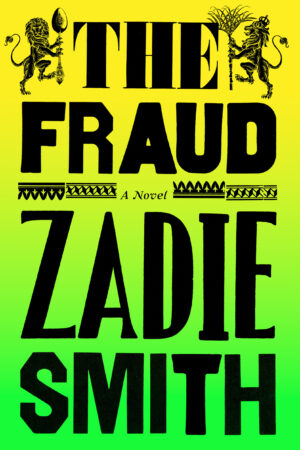The Fraud
by Zadie Smith
reviewed by Bailey Sincox
Zadie Smith’s novels measure the weight of history as it is borne by ordinary people. Her first book, White Teeth, like Gabriel García Márquez’s One Hundred Years of Solitude, Salman Rushdie’s Midnight’s Children, and Toni Morrison’s Beloved before it, told a national story through a multigenerational family narrative. Though her subsequent novels differ in scale and subject matter, they all feature characters grappling in some way with the British Empire and its legacies.
The Fraud, however, is the first “historical novel” Smith has written. The book begins with “the sheer weight of literature” crashing from one floor of Victorian novelist W. Harrison Ainsworth’s house to the other; his many tomes put a “terrible strain” on the ceiling, causing it to cave in. Eliza Touchet—Ainsworth’s cousin-in-law, housekeeper, and sometime lover—is tasked with setting things to rights. Both history and fiction hang in the balance.
Through Eliza, the reader learns of the infamous Tichborne Trial, which unfolded over the 1860s and 1870s in Victorian England. The plaintiff, also known as the Claimant, purports to be one Sir Roger Tichborne, heir to a fortune. The defendants insist he is really Arthur Orton, a butcher from Wapping. As London obsesses over the trial, so does the Ainsworth household. Ainsworth’s new wife (and former maid), Sarah, is a “thorough believer” in Sir Roger, insisting “the rest is only conspiracy and lies and prejudice” against a man who looks and sounds working class. Ainsworth, on the other hand, reduces Orton to his class identity: “Family tells, my dear. Breeding tells. I would know a gentleman in a moment, as would any gentleman. The difference is profound.” Despite her skepticism, Eliza Touchet is nonetheless compelled by the testimony of Andrew Bogle, a man formerly enslaved in Jamaica, who unswervingly supports Tichborne/Orton.
Smith’s subject is not so much the historical trial itself as the court of public opinion that formed around it. Whose testimony is considered credible? Why—and by whom? These questions propel The Fraud forward as its chapters range from 1830 to 1873, detailing the protagonists’ overlapping lives. In the 1830s, Eliza Touchet and Ainsworth’s first wife, Frances (also Eliza’s lover, in an underdeveloped queer subplot), become abolitionists. When fugitive and manumitted black men testify to slavery’s horrors, the women believe them. But when Eliza voices her antipathy toward the slave trade, the Ainsworth coterie’s enfranchised men dismiss her as a political naïf.
But Eliza’s story doesn’t end there—she insists on dredging up the facts of the case even after it has been settled. In 1873, Eliza is drawn once more to Bogle, remembering the abolitionist orator’s pathos and conviction. After the Claimant loses, she poses as a reporter, asking Bogle for his “story.” Bogle replies: “Madam. I have spoken. I have spoken and I have not been believed. I think I have now finished speaking. Sir Roger is ruined. And if he is ruined, how much more ruined am I?” Discredited in court because of his race, Bogle rejects Eliza’s offer to turn his words into a sentimental tale. In the face of Bogle’s self-possession, Eliza thinks he is not “like those musical voices of memory, pleading his case. On the contrary, it was Eliza who now found herself pleading.” Bogle flips the script of journalistic authority.
By interweaving Eliza’s story and Bogle’s, The Fraud links the evidentiary value of testimony and of narration. Bogle eventually shares his history with Eliza; she, in turn, begins writing a novel about the case. Smith, like Eliza, is anxious not to reduce Bogle to an archetype or a symbol. Through Touchet, Smith theorizes the relationship between her authorship and The Fraud’s historical subject matter. As a Catholic Scotswoman, Eliza occupies a precarious place in London society, somewhere between Bogle and Ainsworth. Ainsworth writes novels about Dick Turpin and Jack Sheppard, fabricating the cant of robbers and thieves (just as Charles Dickens does with Fagin and Magwitch). Mrs. Touchet—pronounced touché, not touch-it—sounds like a Dickens character but is, in fact, a historical person—one who wants to tell the truth, although she may be incapable of doing so.
Who is the fraud of the title? Is it “The Claimant,” a butcher passing himself off as a baronet? Ainsworth, the minor novelist stealing his best ideas from the illustrator Cruikshank? Dickens, who likes “fictional people,” “those he can control” more than the “chaos” of “real life?” Or is it Eliza herself, whose good works mask crippling self-doubt? The Fraud lets the reader decide who to believe.
Published on December 7, 2023

